This Chinese Sauce That You Can Pair With Basically Anything
Until recently, I had no idea what XO sauce was; I only knew that I loved it. (To get the Beyoncé puns out of my system from the top: I loved it like XO.)
Related: The 8 Essential Tools for Chinese Cooking
The first time I tried it was at Chris Jaeckle’s Japanese-Venetian restaurant in Greenwich Village, All’onda. The fatty, briny, garlicky sauce was so delicious—and so different from anything I’d tried before—that I can’t even remember the vegetables (pasta?) it covered. But, as I’ve since learned, that’s the point of XO sauce—to be so overtly rich that it steals the show.
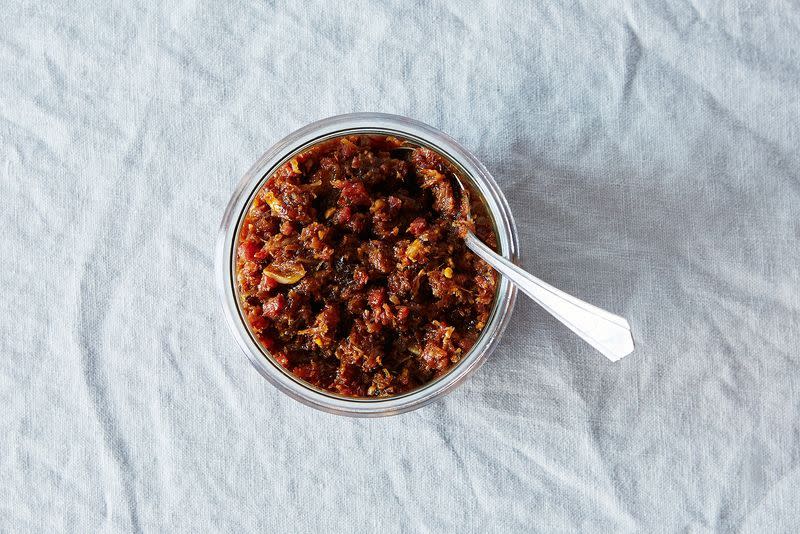
Let’s figure you out. (Photo: Bobbi Lin/Food52)
Developed in the 1980s in Hong Kong, XO sauce is named after a descriptor on bottles of Cognac, popular in China, to denote “Extra-Old.” While the sauce itself doesn’t contain Cognac or any liquor for that matter, the adopted name—a brilliant marketing strategy—implies that, like aged Cognac, it is also luxurious.
Related: 12 Asian Noodles You Should Be Eating More Of (& How to Do It)
And, as with Cognac and other high-end liquors, it felt so shrouded in mystery to me that after tasting it several times, I couldn’t even begin to decipher what went into it.
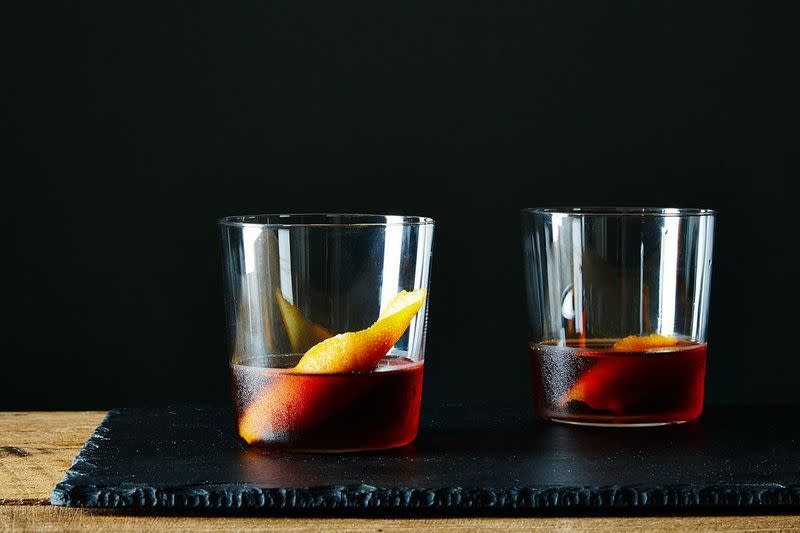
Cognac—and the luxury it implies—served as the inspiration for XO sauce in the 1980s. (Photo: James Ransom/Food52)
I had so little a clue that at a subsequent dinner at All’onda, I assured the vegetarians I was dining with that it was “maybe, kind of vegetarian?” But, as I’ve since learned, XO sauce couldn’t be further from vegetarian (I’m sorry, vegetarian friends, if you are reading this now).
Related: 5 Dishes with Soy Sauce Marinades
Though there are many versions of the sauce, the basic formula includes dried scallops, dried shrimp, and some type of cured meat. Like I said: not vegetarian. Beyond that, it may include chile flakes, ginger, garlic, spices like cinnamon and anise, shallots, even a little sugar, and an oil to hold it all together. It’s also, like Cognac, expensive—mostly thanks to the dried seafood.
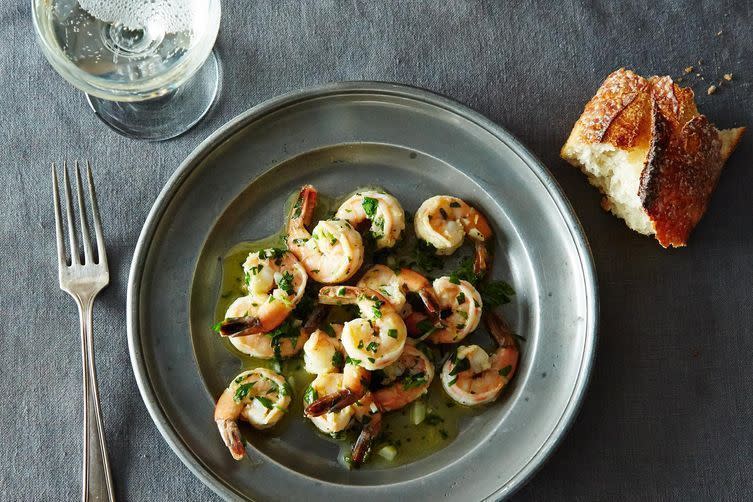
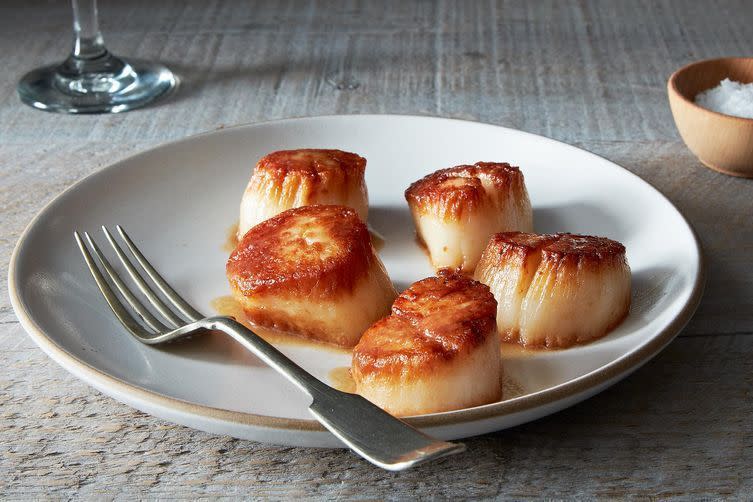
Shrimp and scallops: The two main ingredients of XO sauce. (Photos: James Ransom/Food52)
When I headed to Chinatown on Saturday afternoon, with no fewer than eight printed XO sauce recipes to guide me, I made a beeline to a large store, New Kam Man on Canal Street, that I knew to have a long aisle of dried food. After scouring the aisle—which seemed to hold everything but dried fish—I landed at a corner I’d never noticed before with jars upon jars of dried seafood. Among the jars, which were roughly two-feet tall and half as wide, were six indicating dried scallops and several dried shrimp.
While the shrimp all fell into a similar price range (roughly $25 per pound), the scallops ranged from $23 to $100 per pound. Remembering a Chicago Tribune article that mentioned that dried scallop quality and taste is reflected by its price, I opted for a half-pound of the middle-range ($60 per pound) so that I’d have enough for four batches of (high-scallop-quality) XO sauce. The entire purchase — dried seafood, Shaoxing wine, Chinese sausage, soppressata, vegetable oil, shallots, garlic, and spices — set me back nearly $70.
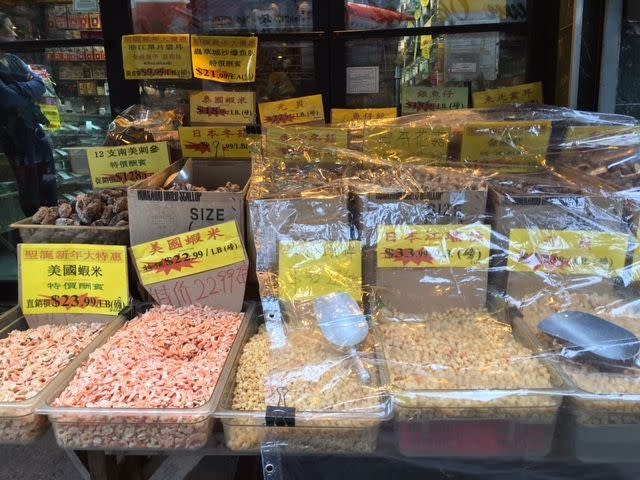
A Chinatown store with buckets of dried shrimp and scallops—among other goodies. (Photo: Leslie Stephens/Food52)
Once I’d exited the store, I learned that the corner of the store that I considered a treasure trove was just a slice of what’s out there. Walking down familiar streets, I discovered maybe a dozen stores I’d never noticed before that sold only dried items — primarily fish — with the outside awnings shading serve-yourself shrimp and scallops, and the higher, indoor shelves offering abalone at up to $4000 per pound.
For those who don’t live in cities with good Chinese markets, there are a number of online stores, including Amazon, where these harder-to-source ingredients are available—even the abalone.

Testing the XO sauce (two beers and a cup of tea into the endeavor). (Photo: Leslie Stephens/Food52)
Attempt 1
After lugging my ingredients home, I made a carefully orchestrated game plan—a piece of paper covered in scrawled changes and arrows—and set to work. Most of the seafood I placed into containers of water to rehydrate overnight, and roughly one-quarter I placed in a steamer. In Danny Bowien’s description of XO sauce in The Mission Chinese Food Cookbook, one of many recipes I looked to, he writes, “soaking the seafood leaches out all the flavor.” Instead, he steams it for 30 minutes.
The only problem with this method was that once I’d steamed the seafood for 30 minutes, and then 40 minutes, and then 2 hours, the fish was not noticeably hydrated. Possibly leaky steamer be damned, I blended the shrimp and fish and set to sautéing them. Forty minutes later, I came face to face with heartbreak: The XO sauce was a burnt, crispy mess.
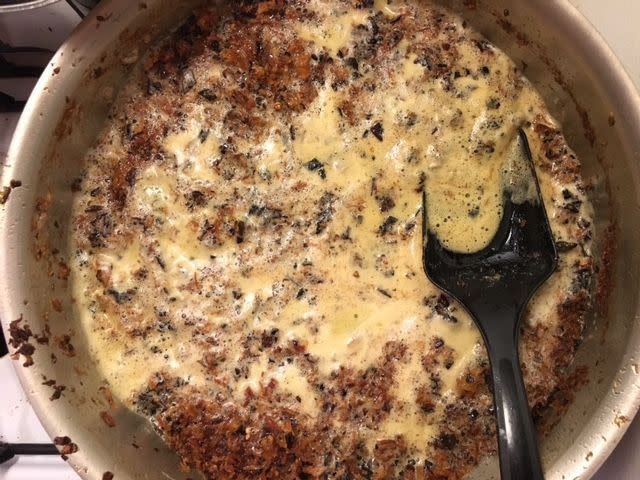
My sad, sad attempt. (Photo: Leslie Stephens/Food52)
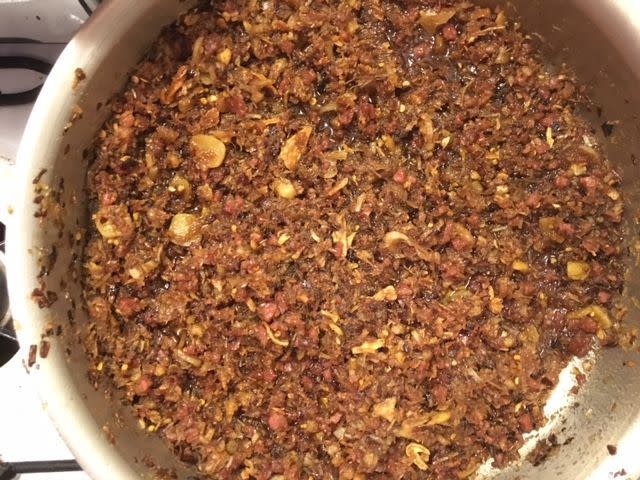
The glorious attempt 3. (Photo: Leslie Stephens/Food52)
Attempt 2
As I mentioned before, the XO sauce of my dreams—the one that launched the trajectory that found me wading through bins of dried fish the day before—was Chris Jaeckle’s. His recipe, which is characteristically Italian-influenced, calls for olive oil and soppressata, so olive oil and soppressata I did.
But for all my carefully-laid plans, I didn’t take into consideration the apparently vast differences between vegetable oil, called for in most of the XO recipes I referred to, and olive oil, which Jaeckle uses. After finding myself with a foamy, oily mess, I discovered that it’s not possible to make a one-to-one swap. I’d used 1 ¼ vegetable oil, following the quantity indicated in the other recipes; he’d used ¾ cup olive oil: It was a world and ½ cup of difference.
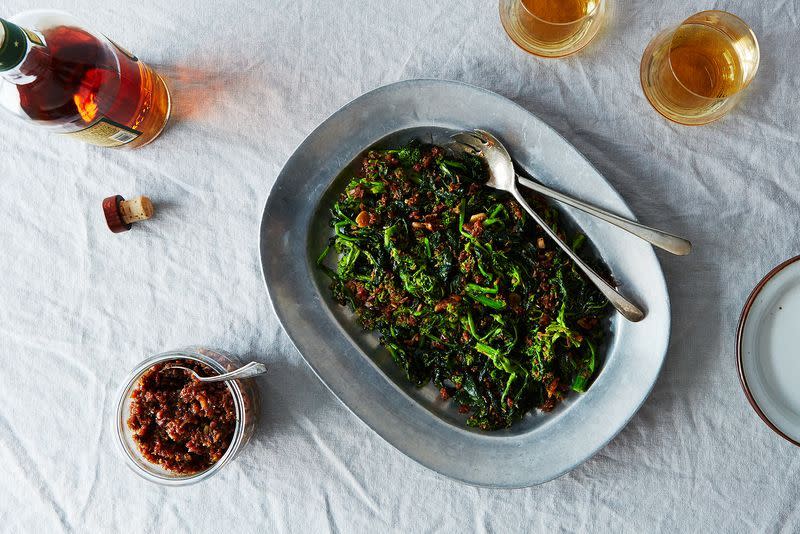
XO sauce with broccoli rabe. (Photo: Bobbi Lin/Food52)
Attempt 3
For my next trick, I stuck with the classics: I used the seafood soaked overnight and kept my vegetable oil close. But instead of using all-Chinese sausage, I took a cue from Jaeckle and subbed in half-soppressata.
After reading through my trove of Google-sourced XO sauce recipes, some versions seemed too spicy-sweet, and others did not hold back on the garlic (and this is coming from a garlic-lover). I doctored my Franken-recipe (a mishmash of 6 to 8 recipes) to hit a happy medium, with vinegar-y Shaoxing wine balancing the sweet sausage, and put a kibosh on the Thai bird chiles. As Danny Bowien’s recipe recommends, I made note to stir in a fried element at the end. He adds fried garlic, but I pulled the fried onions from the back of my cabinet and a bag of scallions I’d bought on impulse in Chinatown.
The end result was delicious: fatty, briny, and garlicky, but also spicy, textured, and unbelievably addictive. In one dinner, I ate it three ways: In a pesto pasta in lieu of chorizo (yes, pesto—it worked and it was glorious!), with sautéed broccoli rabe, and straight from the pan.
Other ways to serve XO sauce:
Over salmon
Sautéed with brussels sprouts
In fried rice
On top of a pan-seared tofu
Tossed with roasted cauliflower florets or tahini-roasted broccoli
As a pasta sauce
On/with/near literally anything else
Attempt 4 never happened—I was too distracted gorging on Attempt 3—but when it does, I will be putting it all over all of the above.
Makes slightly under 1 quart
½ cup dried shrimp
½ cup good-quality dried scallops
4 ½ ounces hot soppressata, diced
½ cup Chinese sausage, about 2 links, cut into rounds (or bacon with 1 tablespoon honey added)
1 ½ cups vegetable oil, or any neutral oil (do not use olive oil), plus more as needed
1 shallot, finely chopped
4 cloves garlic, sliced
2 tablespoons dried red chile flakes, plus more as desired
One 3-inch piece fresh ginger, peeled and chopped
4 star anise
1 cinnamon stick
2 tablespoons Shaoxing wine or dry sherry
2 tablespoons soy sauce
¼ cup fried onions
½ cup fried scallions (or an additional ¼ cup fried onions)
Rehydrate the shrimp and scallops: Set each in a separate Tupperware container so that both the shrimp and scallops are submerged with water. Cover the container in an airtight lid (so that they’re pungent smell doesn’t get out, and your pet doesn’t get in), and set aside to soak for 8 hours, or overnight. Drain before using.
Place the hydrated shrimp and scallops into the food processor. Pulse several times until blended into a uniform shape, scraping down the sides to make sure everything blends evenly—the scallops will look rough and stringy, but should be completely blended with the shrimp. Transfer the shrimp-scallop mixture to a large bowl, then add the soppressata and Chinese sausage into the food processor. Pulse until blended and uniform, about 10 seconds.
In a medium, heavy-bottomed pan, heat the vegetable oil over medium-low until shimmering. Add the shallot and cook until just barely browned, then add the garlic and sauté until the garlic is just browned, about 1 minute.
Add the fish and meat mixture and cook over medium-high heat for 1 minute, then lower the heat and add the red chile flakes, ginger, anise, and cinnamon. Reduce heat to low, and simmer uncovered, stirring occasionally, for 30 minutes, then mix in the Shaoxing wine and soy sauce and cook for another minutes, until the fat has rendered and the mixture appears mostly dry. It’s important to keep stirring in order to keep the garlic and meat on the bottom from burning. Mix in the fried onions and scallions, then add up to ¼ cup additional oil, as needed. Either place in an airtight container to keep in the refrigerator for up to two weeks or serve with stir-fried vegetables, as a pasta sauce, with shrimp, or over salmon — it goes with almost everything! In the photo here, it’s served with blanched then sautéed broccoli rabe.
Save and print the recipe on Food52.
By Leslie Stephens.

